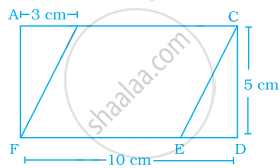Advertisements
Advertisements
प्रश्न
The height of the parallelogram is one-fourth of its base. If the area of the parallelogram is 676 sq.cm, find the height and the base
उत्तर
Let the base of the parallelogram be ‘b’ cm
Given: Height = `1/4` × base
Area of the parallelogram = 676 sq. cm
b × h = 676
b × `1/4`b = 676
b × b = 676 × 4
b × b = 13 × 13 × 4 × 4
b = 13 × 4 cm = 52 cm
Height = `1/4` × 52 cm = 13 cm
Height = 13 cm, Base 52 cm
APPEARS IN
संबंधित प्रश्न
Find the area of the following parallelogram:

Find the missing value:
| Base | Height | Area of parallelogram |
| 20 cm | ______ | 246 cm2 |
If area of a parallelogram is 29.6 sq cm and its base is 8 cm, find its height.
Area of a parallelogram is 83.2 sq cm. If its height is 6.4 cm, find the length of its base.
Find the missing values.
| Base | Height | Area |
| 18 cm | 5 cm |
An agricultural field is in the form of a parallelogram, whose area is 68.75 sq.hm. The distance between the parallel sides is 6.25 cm. Find the length of the base
A square and a parallelogram have the same area. If the side of the square is 48 m and the height of the parallelogram is 18 m. Find the length of the base of the parallelogram
In the given figure, area of parallelogram BCEF is ________ cm2 where ACDF is a rectangle.

Perpendicular dropped on the base of a parallelogram from the opposite vertex is known as the corresponding ______ of the base.
All parallelograms having equal areas have same perimeters.
